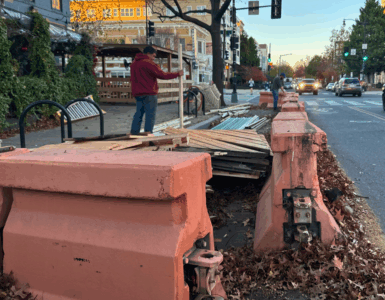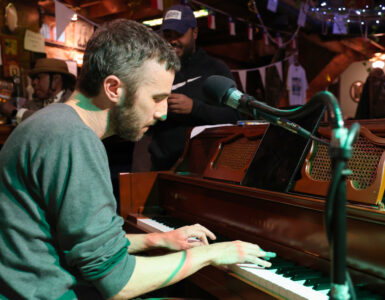By Isabel Umekubo
On a brisk Sunday afternoon, the bustling corner of U Street and Vermont Avenue houses the African American Civil War Memorial.
Aside from a young couple enjoying their drinks nearby or people walking their dogs past the statue, no one is looking at the memorial except me.
The statue depicts four African American Civil War soldiers, who were part of the United States Colored Troops (USCT).
Serving as a tribute, this memorial dedicates its remembrance to 209,145 soldiers of the USCT who fought for the Union during the Civil War. The wall behind the statue lists the names of the soldiers and regiments.
The emptiness around the memorial is eerie, almost a haunting reminder of forgotten history.
As if time travel existed, an American Civil War soldier suddenly emerged from the Metro escalators as if time travel existed.
Only it wasn’t a soldier, it was a man dressed like one, smiling ear to ear as he began to put wreaths, ribbons and Ethiopian flags on the memorial.
Marquett Milton is a historical interpreter with the African American Civil War Memorial Museum. The museum opened in 1999, but is currently closed for renovations.
It will reopen in July at its new, permanent home in the Grimke Building on Vermont Avenue, across from the memorial.

That afternoon, Milton was preparing for a community event: a celebration of the Ethiopian “Battle of Adwa,” in which, in 1896, Ethiopian forces remained victorious over Italy’s attempts to colonize the country.
“I like to call the African American Civil War memorial the silent history of D.C.,” he said.
Following Milton, the area around the memorial erupted in noise after community members, religious leaders and residents came to celebrate.
Every Tuesday through Sunday, proudly in uniform, Milton walks visitors throughout U Street and teaches them about the history of Black soldiers and their historical significance during the Civil War.
Milton has been a museum employee for 15 years and hosts frequent community events, encouraging visitors to learn about the museum’s and memorial’s vibrant histories.
“We’ve been here ever since, meeting people all over the world, telling them the untold story,” he said. “What got me into the history I know now is that I felt like I was lied to my whole life about African American history and about U Street.”
Milton shared that his mission is to learn as much as possible about what U Street was once like.
“I love to meet people and not too many [of them] know our story,” he said, referencing both the museum and the memorial. “It’s been swept underneath the rug.”
Civil War history hardly ever covers the resistance of Black soldiers and troops, added Milton. While Confederate monuments still exist in the United States, Black history, especially in D.C., is rarely known.
“They left our history out on purpose because they didn’t want us to know who we are,” he said. “Because those who don’t have a past will not have a future.”
He added that a part of that history is now, as gentrification has left residents displaced or moving to Maryland and Virginia.
Gentrification is where an “influx of new people drive up the value of real estate, making it difficult for longtime residents and familiar businesses to remain,” according to a WETA neighborhood guide.
These events not only change a place’s character but often erase the significant characteristics that make a neighborhood special.

“These folks, the neighbors, like myself, [have] to work more than one job just to afford to live here,” said Milton, a Washingtonian who grew up in the Capitol Hill area.
The museum and other Black businesses in the area are reminders of the rich history of U Street, which is something to hang on to, Milton added.
“That’s part of the U Street legend,” he said. “We’re the heart of it.”
As the museum reopens in July, many might wonder what lies ahead.
The USCT is the root of why U Street exists, emphasized Milton. Every week, he encounters 20 to 30 people who find their relatives on the memorial walls.
The memorial reminds us of those who helped build the nation and represents their history in the nation’s capital.
Future efforts for the museum include building a theater and a children’s space for youth to learn more about the Civil War soldiers and their ties to U Street.
“We have information about the past that connects with the present,” said Milton. “It could wake the mind of young people into civil rights to make change. It could make a difference.”
During a time when the current presidential administration cracks down on the arts, preserving Black history through the arts still remains.
“[The museum] is like a temple of learning about America’s story and the information that should have been taught,” he said. “They are the true heroes.”
Aaron Lewis, a friend of Milton, is the president of the U Street Neighborhood Association – an all-volunteer organization focused on public safety, community voices and giving back to the neighborhood.
Lewis, a resident of U Street since 2021, said that he met Marquett while trying to use AI to take him on a tour of the area.
“It felt like this beautiful symbol of how even in the age of AI, we have access to such a wealth of information,” he said. “Nothing beats a living historian who’s going to actually, fully embody the character and give you a real visceral sense of what these stories are.”
Temperance Alley Garden, a community gathering place, was one of Lewis’s projects with the community.
He also assists Milton in hosting community events at the African American Civil War Memorial.
“Marquett has done a really great job of activating that site and bringing together people for various celebrations throughout the year,” said Lewis. “We want to continue to support him in that work, because it’s super important for people to learn these histories and to help carry all the rich stories.”
Not far from the memorial lies Garrison Elementary School, which used to be a contraband camp during the Civil War where formerly enslaved people would set up camp and prepare for battle, according to the school’s website.
“What Marquette and what the museum have done is really bring these stories to the foreground and make sure that the memorializing and remembrance was a part of the whole U Street revitalization,” he said.
Part of this revitalization directly deals with active gentrification issues in the area. Lewis added that it can sometimes feel helpless to combat gentrification in the face of huge economic forces such as increasing housing prices.
“It’s difficult to resist the tides of gentrification and the little piece that we’ve tried to play is advocating for more affordable housing in front of the Zoning Commission, because our garden is the site of a future housing project,” he said.
The efforts of the U Street Neighborhood Association and the museum are intertwined, as they explore the history and empower existing preservation efforts.
Lewis, who is also a designer, added that the arts are a great way to reimagine the stories of U Street – through song, dance, design and more.
“It is also a way of clothing the neighborhood in its history and then making it easier to carry those stories forward,” he said. “It just serves as a really good technology of memory for all of the people who live here to be continually inspired by all the artists who came before and then to try to live in an artful way as we continue to remember those stories.”
Throughout his time in U Street, Lewis said that he learned by observing murals and spending time at historic Black businesses such as Lee’s Flower Shop.
Lee’s Flower Shop is U Street’s premier florist shop and the longest-standing Black-owned flower shop in the country, operating since 1945
When asked what he hopes for the future of U Street – and its arts scene – Lewis said he aspires to embody the “DIY” spirit that so many artists do.
“My hope is that the association and the neighborhood can continue to be a place for collective creativity – where we digest the stories from the past, and then kind of remix them in a way that feels timely and speaks to our now,” he said.
“Marquette always says U Street is the unity within you, which I love,” he said. “I always encourage people who visit to learn about all of those roots and how they’re united in the story of U.”
Natalie Hopkinson is an associate professor of journalism at American University.
A former staff writer for the Washington Post, an author of three books, and an expert on D.C.’s arts & culture history, Hopkinson is an experienced member of D.C.’s diverse arts scene.
“The arts are essential because they are our expression of humanity and our expression of not being erased,” she said. “You cannot tell our American story without places like U Street.”
According to a Washington City Paper article, by 2010, the African American population in the Shaw and U Street neighborhoods had decreased to 30 percent from 80 percent in 1980.
More than 20,000 Black residents were displaced between 2010 and 2013, according to the National Community Reinvestment Coalition.
Hopkinson was also a co-leader in creating the Go-Go Museum & Care, which celebrates historic Black music and arts movements and U Street’s “Black Broadway.”
Go-Go is DC and DC is Go-Go.
The Go-Go Museum and Cafe preserves the legacy and tells the story of the official music of Washington, DC. 🎶 pic.twitter.com/t64tjdktCh
— Mayor Muriel Bowser (@MayorBowser) November 18, 2024
“Go-go music”, pioneered by Black musicians in the 1960s and 1970s, is a subgenre of funk music originating in D.C.
Hopkinson emphasizes the cultural symbolism of “go-go music” and how the efforts to preserve art and Black history should remain.
“These symbols [art] are important because they express power,” she said. “First of all, we’re still fighting the Civil War. It never ended. Otherwise, why are they trying to bring Confederate statues back?”
Derek Hyra is a professor of public administration & policy at American University, specializing in research of urban housing, gentrification, urban politics, and race.
His book, Race, Class & Politics in the Cappuccino City, highlights the rapid increase in gentrification and cultural shifts in D.C.
While Hyra believes that the community around Shaw and U Street once was a hub of black political resistance, especially during the 60s, 70s, and 80s, he is unsure of its status now. .
“Now it’s gentrified, and the price point is very high,” he said. “One-bedroom apartments go for $3000, two apartments can go for $6000.”
Marion Barry and Walter Fauntroy, two very important Black political leaders, were critical in developing civil rights and resistance in the U Street area, according to Hyra.
He emphasized that their leadership and community organizing translate to home rule and Muriel Bowser’s battles with President Trump.
Marion Barry was a former D.C. mayor and city councilmember, while Walter Fauntroy is a civil rights activist and pastor.
Muriel Bowser, the current D.C. mayor, openly opposes President Trump’s push to clear homeless encampments in the city.
“If you want to have a very deep understanding of that, you have to make the leaps from 1864 all the way up to 2024, and the Civil War Museum helps you make those leaps and linkages,” said Hyra.
Echoing Hyra, Milton emphasized his high hopes for the museum’s future. Like time travel, Milton believes its ability to transport visitors to the past is needed now more than ever.
U Street is the universe, the unity in ‘U’. What the system is afraid of is people uniting. That’s what this memorial and this museum are going to do, they’re going to unite people.















This is a wonderful article. It is uplifting to see the black community’s efforts to keep U Street memories alive and heighten our awareness of the hidden nooks and crannies of our nation. I wish them success. Not easy in these times.